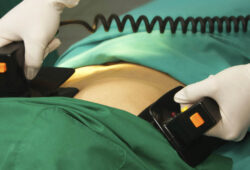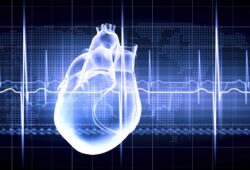Have you ever wondered about the meaning of acronyms such as DES and STEMI that cardiovascular (CV) clinicians commonly use? Some designate a disease and others a treatment or device. In honor of American Heart Month, here are definitions for the most common CV acronyms to keep for future reference:
| CVD | Cardiovascular disease | Diseases of the heart and blood vessels. |
| AMI | Acute myocardial infarction | Heart attack |
| STEMI | ST elevated myocardial infarction | “ST” is a segment of the EKG that becomes elevated in severe heart attacks. |
| NSTEMI | Non-ST elevated myocardial infarction | Non-ST elevated heart attacks are still critically important, although potentially less emergent. |
| ACS | Acute coronary syndromes | Describes a group of conditions due to decreased blood flow in the coronary arteries, such that heart muscle may die. |
| CVA | Cerebrovascular accident | Stroke |
| TIA | Transient ischemic attack | Small stroke with transient symptoms; usually is the precursor to a full stroke. |
| PVD | Peripheral vascular disease | Diseases of blood vessels outside of the heart. |
| CRM | Cardiac rhythm management | Treatment of diseases for irregular heart beats. |
| AF | Atrial fibrillation | Common irregular heart rhythm originating in the upper chambers of the heart. |
| VT | Ventricular tachycardia | A life-threatening irregular, fast heart rhythm originating in the lower chambers of the heart. |
| VF | Ventricular fibrillation | The next level of life-threatening irregular heart rhythm originating in the lower chambers of the heart that typically follows untreated VT. |
| HF | Heart failure | Declining ability of the heart’s pumping action. |
| DM | Diabetes mellitus | A group of metabolic diseases in which there are high levels of blood sugar over a prolonged period of time. Patients may have diabetes requiring treatment with insulin, oral therapies, and/or diet and activity modifications. |
| IDDM | Insulin-dependent diabetes mellitus | |
| NIDDM | Non-insulin-dependent diabetes mellitus | |
| BPHTN | Blood pessureHypertension | Pressure in the blood vesselsHigh blood pressure |
| EKG | Electrocardiogram | Tracing of the heart rhythm, often performed in physician offices. |
| PCI | Percutaneous coronary intervention | Treatment of blockages in coronary blood vessels, performed in a cardiac cath lab via a blood vessel in the wrist or groin. |
| DES | Drug-eluting stent | A metal scaffolding that releases drug into blockages in a coronary blood vessel and holds the vessel open. |
| BMS | Bare metal stent | A metal scaffolding that holds the vessel open, without releasing drug. |
| PPM | Permanent pacemaker | An implantable device to treat low heart rates. |
| ICD | Implantable cardioverter defibrillator | An implantable device to treat fast heart rates. |
| CRT | Cardiac resynchronization therapy | An implantable device to treat patients with heart failure who may also have a fast or slow heart rate. |
| CABG | Coronary artery bypass graft surgery | Blockages in heart arteries are “bypassed” using arteries or veins from the chest or leg. |
| TAVR | Transcatheter aortic valve replacement | Percutaneous treatment of aortic valve disease using a catheter with a premounted valve that is passed through the groin. The valve is placed by inflating a balloon. |
| AVRMVR | Aortic valve repair or replacementMitral valve repair or replacement | During an open chest surgery, the aortic or mitral valve is replaced using a tissue or mechanical valve. The valve may be repaired if there is not too much damage. |
| IABP | Intra-aortic balloon pump | A percutaneous temporary device that is inserted through the patient’s groin to the aorta to assist an acutely weakened heart. |
| LVAD | Left ventricular assist device | A permanent or temporary device that is implanted in a patient’s chest to assist the extremely weakened heart. |
| AAA | Abdominal aortic aneurysm | An abnormal weakening of the aorta (the largest artery in the body) that creates a balloon-like structure that can be life-threatening. |
| EVH | Endoscopic vein harvest | Removing a vein from the leg or arm for use in CABG using a device that allows visualization of the vein. |
| DCB | Drug-coated balloon | A balloon to treat blockages in the legs that is coated with a drug to minimize the blockage coming back. |
| EP | Electrophysiology | The study of electrical activity of the heart. |
| RF | Radiofrequency (ablation) | Radiofrequency energy is used in EP procedures to treat irregular heart rhythms by “burning” the abnormal pathway. |
| VCD | Vascular closure device | After a percutaneous cardiac procedure is performed, these devices are used to “close the hole” in the groin vessel through which the procedure was performed. |
Share Email






